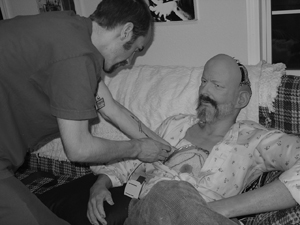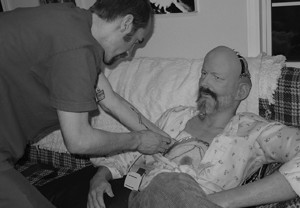 Over the weekend of 24-26 June 2005, Philip K Dick held court in an apartment in San Francisco – he chatted to old-friends and met new fans – and no one, least of all the great man himself, seemed to mind in the slightest that Hollywood’s favourite science fiction author had been dead since 1982.
Over the weekend of 24-26 June 2005, Philip K Dick held court in an apartment in San Francisco – he chatted to old-friends and met new fans – and no one, least of all the great man himself, seemed to mind in the slightest that Hollywood’s favourite science fiction author had been dead since 1982.
Surely, even in his wildest moments, the author of The Man in the High Castle and Do Androids Dream of Electric Sheep could never have imagined that one day, twenty-three years after his death, FedEx would deliver him back into the world. However, a team of scientists, literary scholars, artists and engineers (including the FedEx Institute for Intelligent Systems (IIS), Hanson Robotics and the Automation and Robotics Research Institute) have combined their skills to “resurrect” the author at Wired magazine’s celebration of future technologies, Nextfest.
The android Dick uses 36 servomotors to mimic facial expressions, and a polymer called Frubber that looks and moves like human skin. It uses motion-tracking vision to make eye contact with people in the room, and artificial intelligence and speech software to enable it to take part in complex conversations. It can also recognize people – friends, celebrities and family – in a crowd.
The artificial intelligence personality of the robot has been derived mathematically from Dick’s life and works in a manner similar to that described by Dick himself in his book We Can Build You, claim its designers at the IIS.
“It invents new ideas using a mathematical model of Philip K Dick’s mind extracted from his vast body of writing,” says David Hanson, founder of Hanson Robotics. “More than imitating, we’re trying to model it exactly. To create human emulation robotics that would offer robots that look and act pretty much like humans.”
Hanson believes the Dick robot is just a first step and that robots that behave convincingly like humans may be just twenty years away. The technology in the Dick robot may see practical applications much sooner than that. “Rather than waiting until the 2030s, I think we can probably give robots faces a lot earlier,” he said, predicting that this may be as little as two years away.
To heighten visitor’s sense of interaction with a “real” Philip K Dick, the robot was placed in a set designed to look like a 1970s apartment. Sealed off, and soundproofed from the rest of the convention, the android sat on a sofa and attendees queued to chat with “Dick”. In addition, outside the apartment, another bust of Dick covered in frubber was available for convention-goers to touch (to feel the life-like nature of the skin) and a display showed the world from inside the robot’s head – relaying the pictures from the camera “eyes” of the robot in the apartment.
Matrix couldn’t make it to San Francisco to check out the robot for ourselves, but the team behind it stress that the android was intended as a tribute and “powerful memorial” to the author. Paul Williams, a close friend and former literary executor for Dick, worked with the teams creating the robot. What the author himself would have made of it we can only speculate, but Matrix suspects it would have been a hell of a story.
